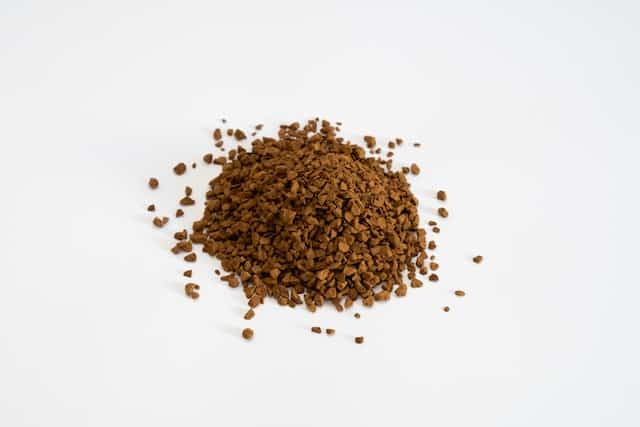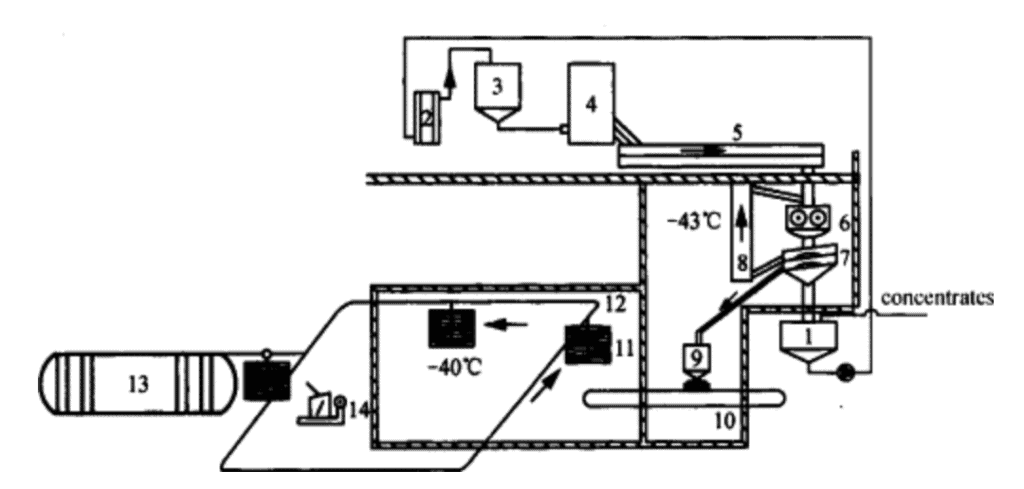Last updated on September 30th, 2023 by Jules Winnfield

Coffee is so embedded, so deeply part of the modern lifestyle that it’s not farfetched to declare it critical to the functioning of society. Yea, coffee is that important.
Not only does it give us the pep we need but it also entertains us with its numerous varieties and variations.
One such variation is the instant coffee. Yes, coffee that can be brewed instantaneously just by pouring in hot water. First debuting around the 1800’s, instant coffee has become super popular (25% of the coffee market) lately because of its convenience and affordability.
One of the many questions people ask is, how is instant coffee made and how is it different from ground coffee.
So we dove into the research, reviewed food and nutrition journals and packaging resources to get the scoop on this instant phenomenon. We review what instant coffee is, how it’s made, and the pros and cons compared to regular coffee.
Ok grab yourself an instant cup and let’s dive in!
What is instant coffee?

Photo by Amr Taha™
Instant coffee, also known as soluble coffee or dried coffee extract, is coffee that has been roasted, brewed and then dried into soluble powder or granules. When you are ready to enjoy a cup of instant coffee, you simply pour it into some hot water or milk. Instantly you have delicious aroma rich coffee.
Benefits of instant coffee
From a practical standpoint, instant coffee is awesome for several reasons.
First, its super convenient. How quick can you get a cup of coffee in your hands ready to go? Like in seconds. Just measure, scoop, pour, mix and you’re done.
Secondly, it’s economical. With brewed coffee, you need a coffee maker, coffee filters, and other brewing tools. Instant coffee doesn’t require any of those things to get a hot rich flavorful cup, saving you time and money.
Third it’s versatile. Unlike brewed coffee, instant coffee can come with lots of different added vitamins and minerals. For example, the low temperature needed to brew instant coffee makes it suitable for probiotic enrichment without killing the good bacteria.
Is instant coffee bad for you?

Photo by Monisha Selvakumar
From a health perspective, coffee is already known to have positive health benefits like improved immune function, reduced risk of chronic diseases including cancer. So on one hand, instant coffee may convey similar effects too, including cardiovascular benefits.
On the other hand, instant coffee may have negative effects. This study for example showed that instant coffee may have a negative effect on telomeres length.
Telomeres are the end genes on your chromosomes. When they shorten, it indicates aging and a higher risk of Alzheimer’s, cardiovascular disease and other chronic diseases.
In addition, commercial instant coffee is known to have extra fillers added in that you wouldn’t find in regular coffee grounds such as creamer and flavoring agents. If you are trying to control your calories and intake, this can be a problem.
Drinking instant coffee over time can also increase your heavy metal and lead concentrations. While the risk is low, that’s a bit concerning to me.
How is instant coffee made?

Photo by Gabriel Mihalcea
The process of making instant coffee is simple to understand but really is a complex mechanical and chemical process.
Source, Roast, Extraction
First coffee beans are sourced, roasted and brewed using water and heat, with brewing temperatures up 175 C.
Robusta beans are usually the beans of choice over Arabica for instant coffee given their naturally higher caffeine content (some of which is lost during the process) and cheaper price. But you can find higher quality (and higher priced) instant coffee that use Arabica beans like this Starbucks instant coffee.
Starbucks 100% Arabica VIA Instant Coffee
Concentrate, Drying
Next, the water-soluble coffee extract is collected, cooled and concentrated. Concentrating the coffee extract helps to make the drying process more efficient. The raw coffee concentrate concentration is usually around 40%.
Next, the extract is treated with either freeze-dried (using low temperatures) or spray dried (using high temperatures and pressure) methods to produce dried coffee pellets or instant coffee.
Both methods produce instant coffee granules with similar carbohydrate and caffeine levels (3.0% vs 3.4%). But freeze drying tends to retain more flavor, color and density.
You can also find instant coffee in tons of different flavors and varieties such as organic and specialty grade. Protein infused instant coffee anyone?
Javy Premium Protein Instant Coffee
Packaging
Once made, instant coffee is specially packaged quickly to keep it from losing quality. This is because instant coffee is very sensitive to oxygen, light, and moisture.
So you will see instant coffee usually packaged in a low oxygen atmosphere with CO2 or N added, and low humidity moisture proof conditions. Instant coffee will generally come packaged in glass jar, vacuumed cans, or airtight plastic pouches, mugs or bags.

According to Hua et al., the entire 11 step process can look something like this:
roasting -> grinding -> brewing/extraction -> concentration of extracted liquid -> cooling -> freezing -> sublimation drying -> desorption -> drying -> smashing -> and finally packaging.
In general, the overall quality of the final product will be dependent on the quality of the initially sourced coffee beans, the roasting, the brewing, and of course drying process. This means there is a lot of variability in quality from one manufacturer to another and one batch to another.
What is the difference between instant coffee and brewed ground coffee?

Photo by Coffee with Joshua
Instant coffee and brewed filtered coffee are very different for a few major reasons. And one of those reasons is not because coffee snobs adore filtered coffee and thumb their nose at instant coffee!
The brewing process
Obviously, all that is required to brew instant coffee is to dissolve it in hot water. Some will also add milk to make it more creamy, and delicious.
Brewed coffee on the other hand requires the traditional methods of roasting (if you do that yourself), grinding, measuring, and brewing to extract your coffee. This can be with a plain manual pour over coffee brewer or high-end automated machine, but it still requires more time and energy.
The taste and aroma
One of the big drawbacks to instant coffee is the decreased flavor and aroma. Because of the limited and variable extractions of instant coffee, you don’t get anywhere near the same level of aromatized coffee oils compared to brewed coffee.
Thus, the powerful aroma, taste and full sensory experience you’re used to with brewed coffee is missing in instant coffee.
Now you will see manufactures attempt to fix this by adding in oils to the instant coffee or other additives, but honestly its really not the same.
The caffeine
For the most part, the caffeine levels tend to be equal. According to one study, instant cappuccino brews had equal amounts of caffeine compared to filtered coffee. But it can vary since the contents of instant coffee are variable depending on the extraction and drying process.
Final Thoughts
While instant coffee may not be as sophisticated and as well received as brewed coffee in snobbish coffee circles, the fact is that more people are turning to this soluble coffee alternative. Not only is it easy to use and make, but it’s cheap, affordable and it does not expire.
But the process of how instant coffee is made is definitely complex but fascinating! Hopefully this was insightful and inspires more experimentation in instant coffee.
Which brand of instant coffee is your favorite? Let us know!
If you are more interested in espresso, find out in this article the difference between blonde and regular espresso.
FAQs
Is instant coffee the same as powdered coffee?
When brewed coffee is dried to create instant coffee, it can take the form of pellets, granules, crystals or powder depending on the drying process. So yes, usually powered coffee refers to instant coffee.
Is instant coffee still real coffee?
Yes and no. Instant coffee is basically brewed coffee that is dried into powder form. So yes, it’s real coffee. But the dried version will lack many of the components, volatile oils and flavors you get from brewed coffee. So in that way it’s not the same as real coffee.
Coffee Has Never Read This Good!
Sign up for a FREE newsletter to the best home brewing tips and guides
Thank you for subscribing to The Cup Coffee House Crew! There's a surprise in your Inbox 🙂
Something went wrong.
- About the Author
- Latest Posts

“Jules” is a pharmacist by day and investor, writer, and health nut by night. When he’s not sipping on some coffee laced with MCT oil during an 18 hour fast, he is writing about how to get your coffee grind on or playing Monopoly with his 2 boys and wife. Ahh…life is good!


